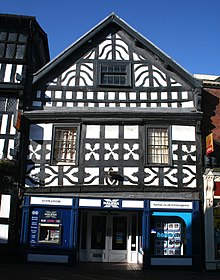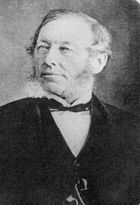Our website is made possible by displaying online advertisements to our visitors.
Please consider supporting us by disabling your ad blocker.
Portal:Cheshire
|
The Cheshire Portal
WelcomeCheshire Plain from the Mid Cheshire Ridge
Cheshire is a ceremonial county in the North West of England. Chester is the county town, and formerly gave its name to the county. The largest town is Warrington, and other major towns include Congleton, Crewe, Ellesmere Port, Macclesfield, Nantwich, Northwich, Runcorn, Sandbach, Widnes, Wilmslow and Winsford. The county is administered as four unitary authorities. Cheshire occupies a boulder clay plain (pictured) which separates the hills of North Wales from the Peak District of Derbyshire. The county covers an area of 2,343 km2 (905 sq mi), with a high point of 559 m (1,834 ft) elevation. The estimated population is a little over one million, 19th highest in England, with a population density of around 450 people per km2. The county was created in around 920, but the area has a long history of human occupation dating back to before the last Ice Age. Deva was a major Roman fort, and Cheshire played an important part in the Civil War. Predominantly rural, the county is historically famous for the production of Cheshire cheese, salt and silk. During the 19th century, towns in the north of the county were pioneers of the chemical industry, while Crewe became a major railway junction and engineering facility. Selected articleCrewe Hall is a Jacobean mansion located east of Crewe. Described by Nikolaus Pevsner as one of the two finest Jacobean houses in Cheshire, it is listed at grade I. Built in 1615–36 for Sir Randolph Crewe, perhaps using drawings by Inigo Jones, Crewe Hall was said to have "brought London into Cheshire", and it was among the county's largest houses in the 17th century. The hall was extended in the late 18th century and altered by Edward Blore in the early Victorian era. It was extensively restored by E. M. Barry after a devastating fire in 1866, and is considered among his best works. The restoration also employed J. Birnie Philip, J. G. Crace, Henry Weekes and the firm of Clayton and Bell. The interior is elaborately decorated and contains many fine examples of wood carving, chimneypieces and plasterwork, some of which are Jacobean in date. The park was landscaped during the 18th century by Lancelot Brown, William Emes and Humphry Repton, and formal gardens were designed by W. A. Nesfield in the 19th century. The stables quadrangle is contemporary with the hall and is listed at grade II*. Selected imageMany of the listed buildings in the centre of Nantwich are half-timbered, black-and-white buildings built shortly after the Great Fire of 1583. This single-gabled example on the High Street, adjacent to the Crown Hotel, displays decorative panelling and a second-storey jettying. Credit: Espresso Addict (11 August 2007) In this month1 October 1827: First stone laid of Grosvenor Bridge, Chester (pictured). 1 October 1905: Inventor John Dolphin born in Christleton. 3 October 1953: First public motor race at Oulton Park. 5 October 1963: Journalist Nick Robinson born in Macclesfield. 10 October 1654: Frodsham Castle destroyed by fire during the Civil War, after the death there of John Savage, 2nd Earl Rivers. 10 October 1868: Runcorn Railway Bridge officially opened. 10 October 1960: Alan Garner's The Weirdstone of Brisingamen first published. 11 October 1678: Antiquarian Sir Peter Leycester died in Nether Tabley. 14 October 1869: Chester Town Hall officially opened by the future Edward VII. 14 October 2017: Mersey Gateway Bridge opened. 16 October 1643: Acton and Dorfold briefly captured by Royalists. 17 October 1832: Grosvenor Bridge, Chester, officially opened (still incomplete) by the future Queen Victoria. 17 October 1934: Novelist Alan Garner born in Congleton. 19 October 1359: A great storm destroyed the nave of Vale Royal Abbey. 19 October 1965: Train driver Wallace Oakes awarded the George Cross posthumously. 20 October 1891: Physicist and Nobel prize winner James Chadwick born in Bollington. 21 October 1650: First record of the Cheshire cheese trade with London. 22 October 1996: Helicopter crash near Middlewich killed five people, including Matthew Harding, vice-chair of Chelsea F.C., and journalist John Bauldie. 26 October 1865: Equestrian Statue of Viscount Combermere unveiled in Chester. 27 October 1874: Mill fire killed eight people at Over. Selected listThe output of Chester-based architect John Douglas (1830–1911) included 40 new churches, as well as work on existing churches and church furniture. The majority of his works were in Cheshire and North Wales. His architectural styles were eclectic, but as he worked during the Gothic Revival period much of his output incorporates elements of the English Gothic style. His new churches (St Wenefrede's, Bickley pictured) date from the early 1860s until his death. They are in a range of materials including sandstone and red and other coloured brick; a few examples use half-timbering. His church restorations were influenced by the Oxford Movement, which advocated a shift in emphasis from preaching to the sacrament of the Eucharist, and thus from the pulpit to the altar. Consequences of this included moving the pulpit from a more central position to the side of the church, replacing box pews with open pews, creating a central aisle to give a better view of the altar, and removing galleries; a larger chancel was also required for the associated ritual. One of the hallmarks of Douglas' designs is the attention to detail, especially in wooden articles, and his church furniture often incorporates highly detailed wood carving. GeographyTop: Map of modern Cheshire showing urban areas (grey) and the major road network. Chester (red) is the county town, and Warrington has the greatest population. Towns with more than 10,000 inhabitants in 2011 are highlighted; the size of dot gives a rough indication of the relative population. Wales and the adjacent English counties are shown in capitals. Bottom: Relief map showing the major hills. The Mid Cheshire Ridge is a discontinuous ridge of low hills running north–south from Beacon Hill (north of Helsby Hill) to Bickerton Hill. Most other high ground falls within the Peak District in the east of the county. Shining Tor (559 metres), on the boundary with Derbyshire, forms the county's high point. Administration The ceremonial county of Cheshire is administered by four unitary authorities (click on the map for details): 2 – Cheshire East 3 – Warrington 4 – Halton In the local government reorganisation of 1974, Cheshire gained an area formerly in Lancashire including Widnes and Warrington. The county lost Tintwistle to Derbyshire, part of the Wirral Peninsula to Merseyside, and a northern area including Stockport, Altrincham, Sale, Hyde, Dukinfield and Stalybridge to Greater Manchester. Selected biographyEdmund Sharpe (31 October 1809 – 8 May 1877) was an architect, architectural historian, railway engineer and sanitary reformer, who was born in Knutsford. As an architect, he predominantly designed churches, of which around forty survive; Cheshire examples include St Wilfrid's, Davenham, and Holy Trinity, Northwich. He pioneered the structural use of terracotta in the so-called "pot" churches, such as St Stephen and All Martyrs', Lever Bridge. He also developed railways in the north-west of England, and championed the construction of new sanitary works in Lancaster, where he practised in 1835–1851. Sharpe achieved his greatest recognition as an architectural historian, publishing many articles, books and detailed architectural drawings. He criticised the widespread practice of restoring medieval churches, and devised a scheme for the classification of English Gothic architectural styles. In 1875, he was awarded the Royal Gold Medal of the Royal Institute of British Architects. Did you know...
Selected town or villageWarrington stands at the lowest bridging point of the River Mersey. Historically within Lancashire, it became part of Cheshire in 1974. With an estimated population of around 210,000 in 2019, it is the county's largest town. The Warrington unitary authority also encompasses 18 civil parishes. The site has been an important crossing place on the Mersey since prehistoric times. A large Roman industrial settlement centred on modern Wilderspool stood on the south bank. It declined after the end of the 2nd century, and a Saxon settlement was established on the north bank, recorded in the Domesday Survey as Walintune. By the Middle Ages, it had emerged as a market town. Warrington's expansion and urbanisation coincided with the Industrial Revolution, particularly after the Mersey was made navigable in the 18th century. In the 19th century, industries included wire drawing, textiles, brewing, tanning and soap manufacture. Further growth occurred after it was designated a new town in 1968. An IRA bomb attack in the centre in 1993 killed two children. Several medieval churches survive, and the town has a museum and art gallery. In the news29 October, 1 November: Warrington council and the mayor of Crewe each announce plans to bid for city status in 2022. 13–14 October: Prince Edward visits Chester and opens a Fire Service training centre in Winsford. 8 October: Castle Street shopping area in Macclesfield reopens after refurbishment. 4 October: Restoration of the grade-I-listed Bridgegate, part of Chester city walls, is completed. 25 September: A bronze frieze by the sculptor Tom Murphy is unveiled in Warrington, as a memorial to the band Viola Beach. 9 September: The fifth stage of the Tour of Britain cycle race takes place in Cheshire, starting at Alderley Park and finishing in Warrington. 24 July: The grade-II-listed Crewe Market Hall (pictured) formally reopens after refurbishment. 15 July: Crewe, Runcorn and Warrington are awarded potential funding under the "Town Deal" government scheme. QuotationThe ayr is very wholesome, insomuch that the people of the countrey are seldom infected with Diseases or Sicknesse, neither do they use the help of the Physicians, nothing so much, as in other countries: For when any of them are sick, they make him a posset, and tye a kerchieff on his head; and if that will not amend him, then God be merciful to him! The people there live till they be very old; some are Grandfathers, their Fathers yet living; and some are Grandfathers before they be married. From The Vale Royall of England by Daniel King (1656)
Subcategories
TopicsRecommended articlesThings you can do
WikiProject Related portalsAssociated WikimediaThe following Wikimedia Foundation sister projects provide more on this subject:
Discover Wikipedia using portals |
Previous Page Next Page









































